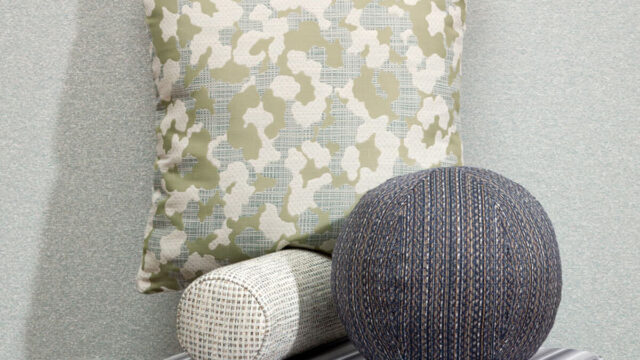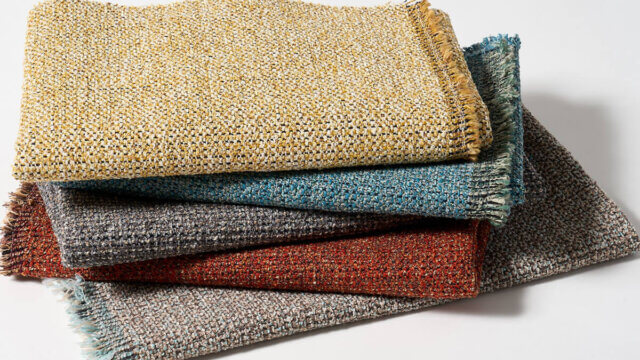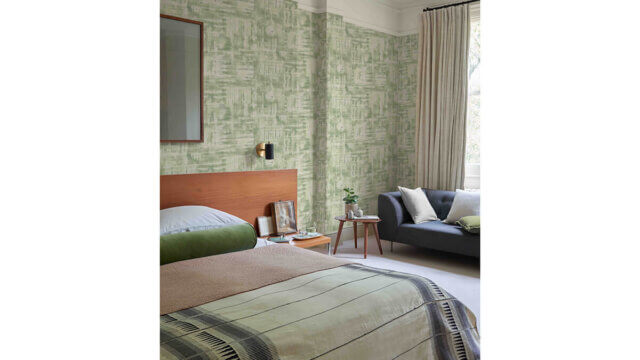Wolf-Gordon has introduced its latest concept-driven collection of digitally printed PVC-free wallcoverings. For “Project: HI > AI”, Curator and Chief Creative Officer Marybeth Shaw invited seven creatives to develop original patterns. The artists submitted verbal descriptions of their work that were subsequently input into AI imaging software and, in most cases, edited by Shaw and Michael Loughlin, Wolf-Gordon design director, to achieve a more relevant approximation or contrast with the original art. A timely snapshot of the meeting of human intelligence and artificial intelligence, “Project: HI > AI” is an industry first for commercial surface design.
Ranging from printmaker to conceptual artist, art jeweler to sign painter, the artists represent diverse media, cultural backgrounds and geographies: Hilary Lorenz, print media artist, Abiquiu, NM; Raylene Marasco, textile artist and founder, Dyenamix, NYC; Jen Mussari, calligrapher and sign painter, Brooklyn; Pat Pruitt, metalsmith, Ada, OK; Christine Tarkowski, artist and professor, SAIC, Chicago; Frank Tjepkema, designer and founder, Tjep, Amsterdam; and, Ghislaine Vinas, interior designer, NYC.

Shaw launched the project with a song, “Human Behavior” by Bjork (1993), which was written from the perspective of an animal observing humans. She suggested that for “Project: HI > AI”, humans might be replacing the animal with a machine. Each creative explored diverse themes such as the process of making, the uniqueness of human-generated art, and anxiety over impinging technology, surveillance and control in our lives. Although the AI software could not match the human’s creations, the results are remarkable for their range of interpretation and, in some instances, outputs that delight for their otherworldly takes on organic and traditional motifs, hand-drawn and -painted compositions, and multi-step art-making processes.
Large Square, a pattern by Christine Tarkowski, artist and professor at the School of the Art Institute of Chicago, was generated by folding water-soaked butcher paper repeatedly into a square, and then drizzling 2000-degree Fahrenheit molten glass onto the folded paper. The glass burned through several layers, revealing a pattern when it was extinguished and unfolded. While Tarkowski’s juxtaposition of geometry to entropic action—a persistent theme in her work—was impossible for the AI to match, the image of folded paper aflame in the AI version is relatable.
Pattern 2, designed by calligrapher and sign painter Jen Mussari, explored the foundational shapes of her art. When Wolf-Gordon Design Studio input Mussari’s prompt—’a linear pattern of calligraphy brush strokes reminiscent of the building blocks of hand-drawn typographic forms’—the super-graphic output from the AI software was so compelling that they kept it as a large non-repeating mural.
Famossa, an abstracted, pointillist floral motif by designer Frank Tjepkema, was created on CAD software with a lengthy list of words that yielded a better result when edited down. “Magnetic field, organic, floral, parametric,” output a fantastical, alien flower that one might encounter on Naboo (Queen Amidala’s planet).
Furrows, designed and hand painted by textile artist Raylene Marasco, required rearranging of the original prompt and additional cues like “brick-like layout” and “soft gray color.” While less nuanced than Marasco’s painting, which she executed by dragging pigment down an unevenly hand-dyed fabric with a vintage metal graining comb, its AI counterpart is a complex light-infused pattern that resembles a high-tech ikat.
Thunder & Lightning, a pattern by Native American metalsmith Pat Pruitt, proved too geometrically abstract for the AI software to replicate. In Pueblo art, lightning symbolizes the water serpent, Avanyu, and the importance of rainfall to desert agriculture. Pruitt’s particular pattern for lightning, also seen on his much sought-after wrist cuffs, was interpreted by AI as a more cartoon-like zig zag.

Migration, designed by print media artist Hilary Lorenz, is a demonstration of the uniqueness of each living being and of each work of art. Lorenz has created awe-inspiring installations of individually printed and cut-out hawk moths, most recently at the Denver Botanic Garden, which celebrate these winged insects as pollinators and metaphors for the exchange of ideas. AI was able to generate a pattern of the moths in flight that could be considered a distant cousin of Lorenz’s concept, at a significantly lower degree of resolution and, notably, in a very cloned, serialized repeat.
Playful Toile, by designer Ghislaine Viñas, explores a tableau of human-inflicted adversities existing in a developing or, controversially, collapsing world. The pattern is a mash-up of misfortunes with surveillance as a key theme, under the guise of a perfectly pleasing pattern. The traditional wallpaper pattern output by AI couldn’t match the degree of threat designed by Viñas.
Beyond the possibility to utilize AI imaging software in commercial pattern design and the crucial role of language in the translation of imagery, the exhibition highlights what Shaw refers to as the rupture in viewing AI-generated art.
“Often, there is something about AI imagery output that gives us pause. We sense something different that reads as a visual misunderstanding, but, actually, these AI-generated re-presentations of familiar images might provide artists and designers with inspiration for their next steps. Elements of AI imagery will undoubtedly make their way into human-generated works, thus setting up a symbiotic relationship between human and machine in writing, art and design,” said Marybeth Shaw, chief creative officer, design & marketing.
“Project: HI > AI” will be on display in Wolf-Gordon’s Headquarters, 333 Seventh Avenue, New York through the end of December 2023. All seven human-generated patterns will be available through Wolf-Gordon’s Curated Collection.
Curated Collection
The Curated Collection allows interior design specifiers to incorporate distinctive imagery from a select group of artists, with the added flexibility of various modification options including size, scale, coloring and even printing substrate. Curated Collection digital wallcoverings become feature walls in interiors, rendering projects unique and site-specific—whether behind a headboard or reception desk, in a customer waiting area, restaurant, or an office space. Working closely with WG Customs Lab, designers can choose from a variety of substrates, including embossed vinyl and PVC-free textured wallcoverings, Mylar finishes, felt and textile materials, acrylic panels, window films, as well as Wolf-Gordon’s RAMPART wall protection for high-impact areas.




